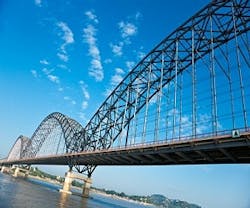New Method for Detecting and Measuring Bridge Damage
A ratings system developed by a group of Kansas State University researchers is designed to keep bridges safer and help prevent catastrophic collapses.
The researchers have created a bridge health index, a rating system that more accurately describes the amount of damage in a bridge. The health index can extend beyond bridges and apply to other structures, such as gas pipelines, dams, buildings and airplanes.
Hayder Rasheed, associate professor of civil engineering, and Yacoub Najjar, professor of civil engineering, are collaborating to better detect and measure damage in concrete bridges. Ahmed Al-Rahmani, doctoral student in civil engineering, United Arab Emirates, has also been involved in the project.
The engineers have developed ways to take bridge measurements and use finite element analysis and neural network modeling to back-calculate and detect bridge damage. The researchers combined this process of inverse problem solving with Najjar's expertise in neural networks to create the bridge health index.
Current methods of inspecting bridges are very subjective, Rasheed says. Experienced inspectors from the Federal Highway Administration in the U.S. Department of Transportation visually inspect bridges and determine damage amounts. Problems can arise because one inspector may determine a bridge to be 70% damaged, while another inspector maybe determine the same bridge to be 80 percent damaged.
"It varies from inspector to inspector," Rasheed says. "They measure the cracks in the bridge, but they have no objective way to calculate how much it is damaged. Because the inspectors decide which bridges are repaired first, it's very important to make the process objective across the board."
The bridge health index provides a more objective way to determine and compare bridge damage to decide which bridges most need repairs. The network allows inspectors to input parameters, such width, depth and location of cracks in a bridge, and the network will tell the health index of the bridge.
According to the bridge health index, a new, undamaged bridge has a health index of 100. The health index of a bridge goes down as it gets older or as damage occurs.
"The health index is one systematic approach in a sense," Najjar said. "Inspectors gather information about the bridge, put in the information and they receive the health index of the bridge. It makes it easier to study the bridge because you bring all of these dimensions into one number. But when you have multiple dimensions, it is difficult to rate them."
Currently, the researchers and several graduate students have been building and training the health index system with synthetic bridges, which can simulate how bridges will act under certain conditions. The researchers have built the network based on thousands of simulations.
"We take these measurements and we run them through two cycles of analysis," Rasheed said. "We come up with damage detection of where we expect the cracks to be and how deep and how wide they are. It's a very intelligent system."
The next step is to build bridge beams. The engineers will create cracks in the beams and then enter measurements into their network modeling system to determine how well the system can detect and predict cracks. After working with bridge beams, the researchers will test bridges throughout the state.
The researchers said the health index system could lead to safer bridges and prevent catastrophic events, like the 2007 collapse of the I-35W Mississippi River bridge in Minneapolis, from reoccurring.
"If a system like this had existed, inspectors might have foreseen there would be a problem with the Minneapolis bridge," Najjar says. "It might have been weak in certain areas, but other elements might have been very healthy. If you don’t have a health index to reflect that, you won't be able to rate it."
The engineers have also discovered numerous applications of the health index because the same network modeling system can be applied to other structures -- including dams, buildings and airplanes.
"Using this system on airplanes is especially effective because you deal with specific material and you can understand its behavior even better," Najjar says. "You can test the wing of an airplane and find its health index.
